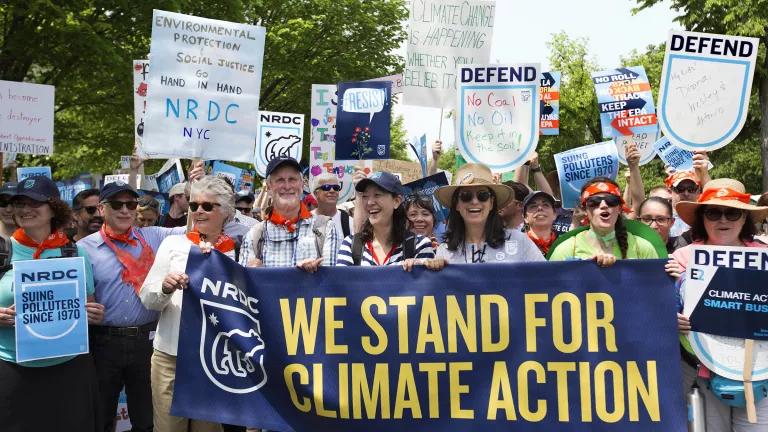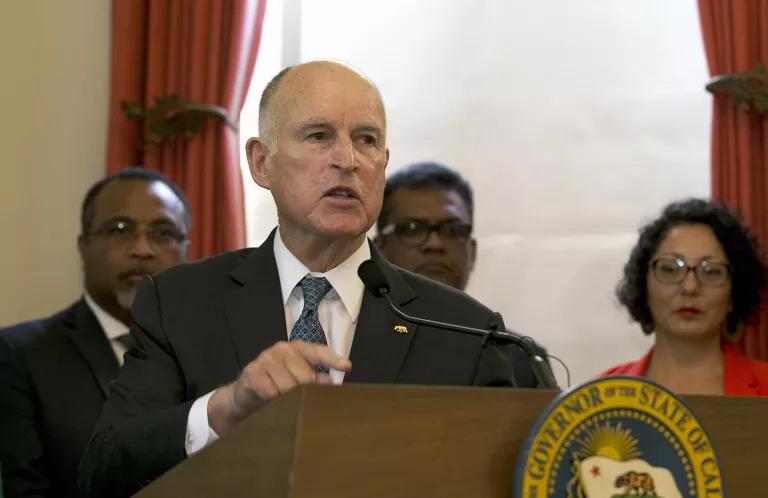The Paris Agreement’s Next Act, Now in San Francisco
NRDC is working to help make the Global Climate Action Summit a success by inspiring more ambitious commitments to the historic 2015 agreement and enhanced pollution-slashing initiatives.

The People's Climate March, April 29, 2017
About a month before the Paris climate summit, Christiana Figueres, then United Nations climate chief, found herself at a crossroads. “A decision must be made,” she wrote in an op-ed in the Guardian, “when we have understood that the consequences of the past need us to intentionally and decisively redefine the future.” She then declared, in no uncertain terms, that the world was ready for change. If the pact signed by 195 countries in December 2015 is any indication, Figueres was right. World leaders’ mutual commitment to hold global temperature rise well below 2 degrees Celsius was a momentous demonstration of international cooperation fueled by the energy of cities, states, businesses, and citizens, all ready to turn the page.
Though America’s federal government has since abandoned its pledge and instead pushed a starkly anti-environment agenda, the global momentum on climate action has not slowed. And now, as we stand more than halfway between the signing of the Paris Agreement in 2015 and the next scheduled step for countries to bolster their commitments, set for 2020, many leaders are upping the ante. At the upcoming Global Climate Action Summit, taking place September 12–14 in San Francisco, representatives from both within and outside the United States will aim to recapture and accelerate some of that decisive spirit cultivated in Paris and encourage one another to take more ambitious action, sooner than planned.
“The main show of the summit,” explains NRDC’s International Policy Manager Brendan Guy, “will be leaders at all levels showcasing the progress they’ve made in the last few years since the Paris Agreement and committing to new actions to move the needle even further.” Guy, who has been serving as a liaison with the summit’s organizers, notes that the summit was initially conceived by Figueres. She wanted to build on the Paris Agreement’s momentum and enlist states, cities, and businesses to encourage national governments to declare more ambitious climate pledges by 2020. NRDC jumped in to help advance this goal, harnessing its strong relationships with international climate leaders and with the office of California Governor Jerry Brown.
Inspired by Figueres’s masterful architecture of the Paris accord, the San Francisco summit will be cochaired by six global climate luminaries—Governor Brown; Patricia Espinosa, the current United Nations climate chief; former New York City mayor Michael Bloomberg, now the United Nations Special Envoy for Climate Action; Anand Mahindra, chair of the India-based Mahindra Group, a company with operations in more than 100 countries; Xie Zhenhua, China’s climate change representative, and Jayathma Wickramanayake, the United Nations Secretary-General’s Envoy on Youth. To encourage leaders to step up their climate commitments, the cochairs have organized the gathering around five key challenge areas: healthy energy systems, inclusive economic growth, sustainable communities, land and ocean stewardship, and transformative climate investments. The summit will also feature a number of crosscutting themes focused on gender, equity, innovation, and security, among other topics.
In addition to the official summit program, hundreds of climate action events, concerts, and exhibitions will take place in San Francisco. Perhaps most notably, the week will kick off on September 8 as people hit the streets not only in San Francisco but in towns and cities all over the world, to march with the Peoples Climate Movement. Organizers are calling the event a “mobilization for climate, jobs, and justice,” demanding bold action from leaders at the summit and holding those who won’t be there—including President Trump—accountable for their inaction.

California Governor Jerry Brown discusses climate change at a news conference.
A number of youth-focused activities and challenges will also play a central role at the summit. Taryn Akiyama, project coordinator of the Under2 Coalition for Governor Brown’s Office of Planning and Research, is working to bring young people to the summit and engage them in its central mission. She and her team of two others are all under 30. Among the activities they’ve helped plan is the Youth Step Up contest, which challenges 18- to 24-year-olds to develop bold climate solutions. Akiyama’s team was also instrumental in bringing Wickramanayake on board as the sixth summit co-chair. A 27-year-old who is charged with leading the UN’s youth engagement and advocacy efforts, Wickramanayake called her appointment to the summit’s leadership committee “a recognition of the transformative power of young people as equal partners in the fight against climate change.”
“It’s so important to get young people early on to be engaged on climate change and how it affects our daily lives,” Akiyama says. “I think our generation, more than older generations, is acutely aware of everything that’s happening. The harder part for younger people is understanding how they can make the most impact, how they can best address this issue on an individual level.” Akiyama and her team are organizing youth networking events; supporting a green career fair and climate literacy events during the week of the summit; and facilitating communications, partnerships, and volunteer activities meant to keep the conversation going well beyond September.
NRDC has played an integral role in the development of the Global Climate Action Summit’s robust programming. NRDC staff are organizing six summit affiliate events on such diverse topics as Latino climate leadership; electric vehicles; city, state, and business climate efforts in India; food waste; the boreal forest; and how smart climate policy is good for business.
A working group of several dozen NRDC staff members, shepherded by Brendan Guy and Annie Notthoff, director of California advocacy, have also collaborated with many summit participants, including the California Ocean Protection Council (OPC). NRDC is part of the NGO Advisory Committee, which is working with OPC to organize and shape the summit session on oceans. Its key message will be that healthy seas are critical to mitigating and adapting to climate change. And, seizing on the rare opportunity to have so many global climate actors in the same place at the same time, NRDC is sponsoring a number of additional events outside the official conference schedule. “Our events will give leaders additional time beyond the main stage to really roll up their sleeves on solutions and better understand the multiple imperatives for urgent climate action,” Guy says. He adds that NRDC hopes the summit and its associated events—such as the Peoples Climate Movement march—also convey the power of grassroots action to achieve change.
In the lead-up to the event, the bottom-up momentum—from communities, faith leaders, grassroots organizations, and more—is already building. Organizers expect the Global Climate Action Summit to be the biggest climate event ever on American soil, and the fact that it is happening at a time when the Trump administration is launching an all-out assault on our air, water, and public health, with a blatant disregard for climate science, is not lost on Guy. “Leaders are coming from all over the globe to the United States while Trump is trying to tear down everything we’ve built,” he says. “The message is clear: The world is still in the Paris Agreement. No matter what.”
This NRDC.org story is available for online republication by news media outlets or nonprofits under these conditions: The writer(s) must be credited with a byline; you must note prominently that the story was originally published by NRDC.org and link to the original; the story cannot be edited (beyond simple things such as grammar); you can’t resell the story in any form or grant republishing rights to other outlets; you can’t republish our material wholesale or automatically—you need to select stories individually; you can’t republish the photos or graphics on our site without specific permission; you should drop us a note to let us know when you’ve used one of our stories.


California’s Climate Whiplash
Heat Stress Is Killing Workers. States Can Protect Them.
Laurie David Is Keeping the Action in Climate Activism